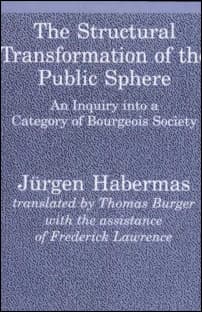Jurgen Habermas on the public sphere, the state, and the private sphere
By Kristopher A. Nelson
in
December 2012
700 words / 4 min.
Tweet
Share
Jurgen Habermas is a German sociologist and philosopher. He is perhaps most well known for the concept of the “public sphere.” Contrasted against this sphere are the state and the private sphere.

Please note that this post is from 2012. Evaluate with care and in light of later events.

Jürgen Habermas is a German sociologist and philosopher. He is perhaps most well known for the concept of the “public sphere.” But what is this sphere? And what can be contrasted against it?1
By “the public sphere” we mean first of all a realm of our social life in which something approaching public opinion can be formed. — Peter Hohendahl and Patricia Russian, “Jürgen Habermas: The Public Sphere: An Encyclopedia Article (1964),” p. 49.
In a note on this passage, Peter Hohendahl explains that the “public sphere” is not the same as a crowd of people per se, but rather consists of institutions (though these do consist of individuals, of course). In today’s liberal democracies, this includes institutions like “newspapers and magazines, radio and television” (49).
Hohendahl also notes that the state (i.e., government) does not overlap with the public sphere, but is in fact an opponent (of a sort). Habermas writes that state authority is an “executor of the political public sphere,” but “it is not a part of it” (49). Hohendahl and Russian clarify this:
Habermas designates that sphere as public which antiquity understood to be private, i.e. the sphere of non-governmental opinion making. The public sphere, then, consists of associations of private individuals, but expresses their group (“public”) will. This will can be directed towards controlling or influencing state activities, but the state remains separate. But this influence by a rational public sphere over state activities is critical to liberal democracies (50).
What is the difference between society and the public sphere?
“Society” is related to the state in a way similar to that of the public sphere: it is “a private realm occupying a position in opposition to the state” (52). But unlike the public sphere, which refers to institutions, society for Habermas consists of people in their private and individual capacities. He notes, though, that in contemporary market-based economies, society extends “beyond the bounds of private domestic authority” (52).
Habermas explains that modern constitutions in liberal democracies sought to protect society “as a sphere of private autonomy” and to limit state (“public”) authority (52-53). They also created a space between the two — the public sphere:
Between these two spheres, the constitutions further insured the existence of a realm of private individuals assembled into a public body who as citizens transmit the needs of bourgeois society to the state (52-53).
The First Amendment of the United States Constitution, which includes both clauses that protect both freedom of speech and of assembly, is an excellent example of constitutional protection for the public sphere.
What, then, is the difference between public and private?
For Habermas, the private sphere is a primarily about autonomy: “a sphere of bourgeois society which would stand apart from the state as a genuine area of private autonomy” (51). This is the area of family, exchange, and even work that revolves around individuals, not institutions. In many respects, “private sphere” and “society” appear to be synonyms to Habermas, as both consist of areas of autonomous activity, that is, activity separate from that of the state (though the state may intrude).
The public sphere thus occupies the space between state (government) actors and private actors, and between “public authority” of the government and the private authority of autonomous individuals. But while this sounds fine, I rapidly find the boundaries blurring. At what point does a group of private individuals become a “public institution”? When they attempt to influence the state? When they attempt to influence other groups? When is a private business part of the public sphere, and when is it “purely” private? Habermas’ definitions are useful, but do not seem to me to be either definitive or firm.
- Note that the term “public” can be confusing, as it can have different meanings. Americans, especially, tend to equate “public” with “government” (as in “public schools”), while Europeans tend to (like Habermas) to equate “public” with non-governmental institutions and groups. Thus, an American public school is state run, but an English public school is the opposite, as it is run by private individuals. ↩